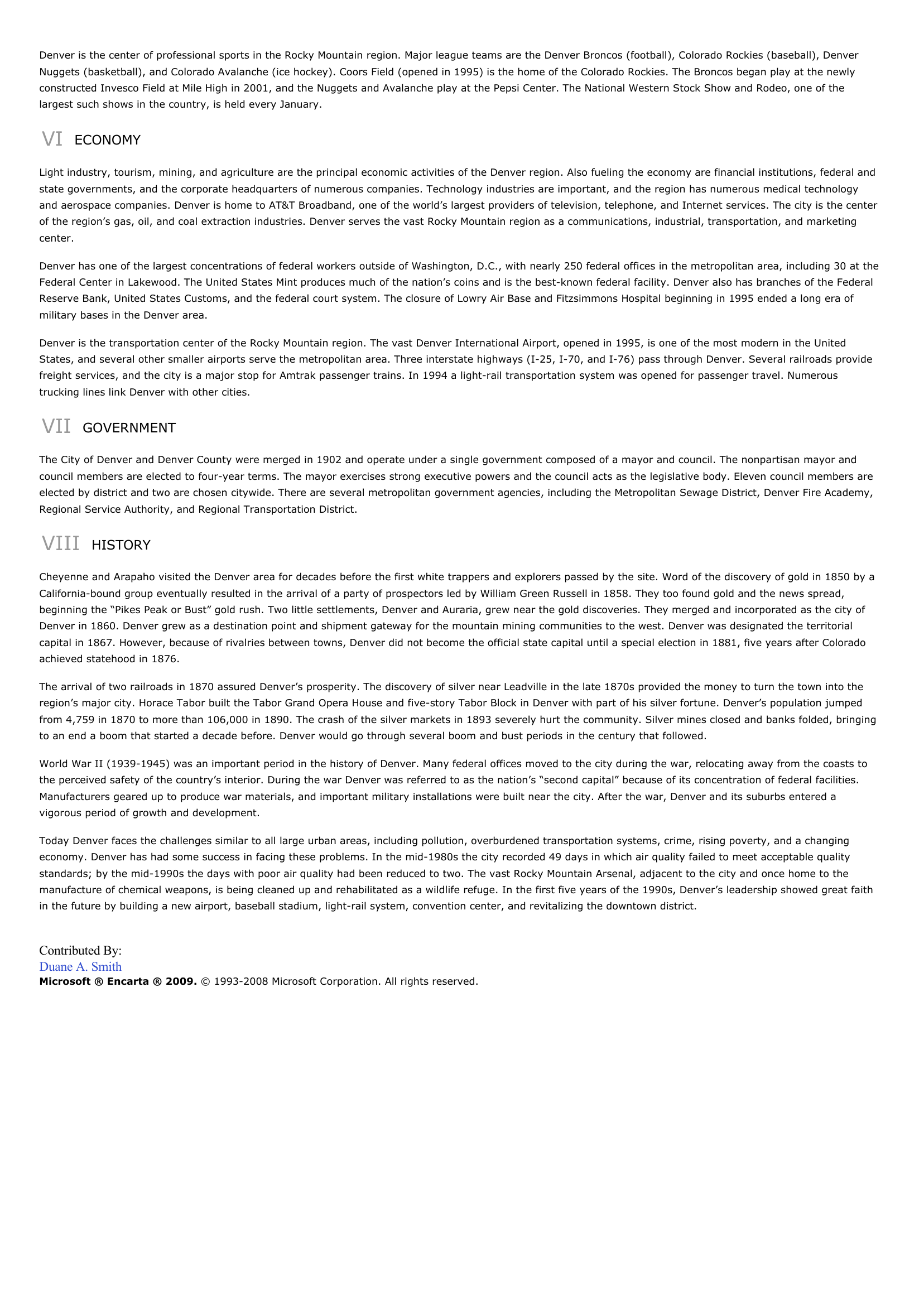Denver - geography.
Publié le 04/05/2013
Extrait du document
«
Denver is the center of professional sports in the Rocky Mountain region.
Major league teams are the Denver Broncos (football), Colorado Rockies (baseball), DenverNuggets (basketball), and Colorado Avalanche (ice hockey).
Coors Field (opened in 1995) is the home of the Colorado Rockies.
The Broncos began play at the newlyconstructed Invesco Field at Mile High in 2001, and the Nuggets and Avalanche play at the Pepsi Center.
The National Western Stock Show and Rodeo, one of thelargest such shows in the country, is held every January.
VI ECONOMY
Light industry, tourism, mining, and agriculture are the principal economic activities of the Denver region.
Also fueling the economy are financial institutions, federal andstate governments, and the corporate headquarters of numerous companies.
Technology industries are important, and the region has numerous medical technologyand aerospace companies.
Denver is home to AT&T Broadband, one of the world’s largest providers of television, telephone, and Internet services.
The city is the centerof the region’s gas, oil, and coal extraction industries.
Denver serves the vast Rocky Mountain region as a communications, industrial, transportation, and marketingcenter.
Denver has one of the largest concentrations of federal workers outside of Washington, D.C., with nearly 250 federal offices in the metropolitan area, including 30 at theFederal Center in Lakewood.
The United States Mint produces much of the nation’s coins and is the best-known federal facility.
Denver also has branches of the FederalReserve Bank, United States Customs, and the federal court system.
The closure of Lowry Air Base and Fitzsimmons Hospital beginning in 1995 ended a long era ofmilitary bases in the Denver area.
Denver is the transportation center of the Rocky Mountain region.
The vast Denver International Airport, opened in 1995, is one of the most modern in the UnitedStates, and several other smaller airports serve the metropolitan area.
Three interstate highways (I-25, I-70, and I-76) pass through Denver.
Several railroads providefreight services, and the city is a major stop for Amtrak passenger trains.
In 1994 a light-rail transportation system was opened for passenger travel.
Numeroustrucking lines link Denver with other cities.
VII GOVERNMENT
The City of Denver and Denver County were merged in 1902 and operate under a single government composed of a mayor and council.
The nonpartisan mayor andcouncil members are elected to four-year terms.
The mayor exercises strong executive powers and the council acts as the legislative body.
Eleven council members areelected by district and two are chosen citywide.
There are several metropolitan government agencies, including the Metropolitan Sewage District, Denver Fire Academy,Regional Service Authority, and Regional Transportation District.
VIII HISTORY
Cheyenne and Arapaho visited the Denver area for decades before the first white trappers and explorers passed by the site.
Word of the discovery of gold in 1850 by aCalifornia-bound group eventually resulted in the arrival of a party of prospectors led by William Green Russell in 1858.
They too found gold and the news spread,beginning the “Pikes Peak or Bust” gold rush.
Two little settlements, Denver and Auraria, grew near the gold discoveries.
They merged and incorporated as the city ofDenver in 1860.
Denver grew as a destination point and shipment gateway for the mountain mining communities to the west.
Denver was designated the territorialcapital in 1867.
However, because of rivalries between towns, Denver did not become the official state capital until a special election in 1881, five years after Coloradoachieved statehood in 1876.
The arrival of two railroads in 1870 assured Denver’s prosperity.
The discovery of silver near Leadville in the late 1870s provided the money to turn the town into theregion’s major city.
Horace Tabor built the Tabor Grand Opera House and five-story Tabor Block in Denver with part of his silver fortune.
Denver’s population jumpedfrom 4,759 in 1870 to more than 106,000 in 1890.
The crash of the silver markets in 1893 severely hurt the community.
Silver mines closed and banks folded, bringingto an end a boom that started a decade before.
Denver would go through several boom and bust periods in the century that followed.
World War II (1939-1945) was an important period in the history of Denver.
Many federal offices moved to the city during the war, relocating away from the coasts tothe perceived safety of the country’s interior.
During the war Denver was referred to as the nation’s “second capital” because of its concentration of federal facilities.Manufacturers geared up to produce war materials, and important military installations were built near the city.
After the war, Denver and its suburbs entered avigorous period of growth and development.
Today Denver faces the challenges similar to all large urban areas, including pollution, overburdened transportation systems, crime, rising poverty, and a changingeconomy.
Denver has had some success in facing these problems.
In the mid-1980s the city recorded 49 days in which air quality failed to meet acceptable qualitystandards; by the mid-1990s the days with poor air quality had been reduced to two.
The vast Rocky Mountain Arsenal, adjacent to the city and once home to themanufacture of chemical weapons, is being cleaned up and rehabilitated as a wildlife refuge.
In the first five years of the 1990s, Denver’s leadership showed great faithin the future by building a new airport, baseball stadium, light-rail system, convention center, and revitalizing the downtown district.
Contributed By:Duane A.
SmithMicrosoft ® Encarta ® 2009. © 1993-2008 Microsoft Corporation.
All rights reserved..
»
↓↓↓ APERÇU DU DOCUMENT ↓↓↓

































